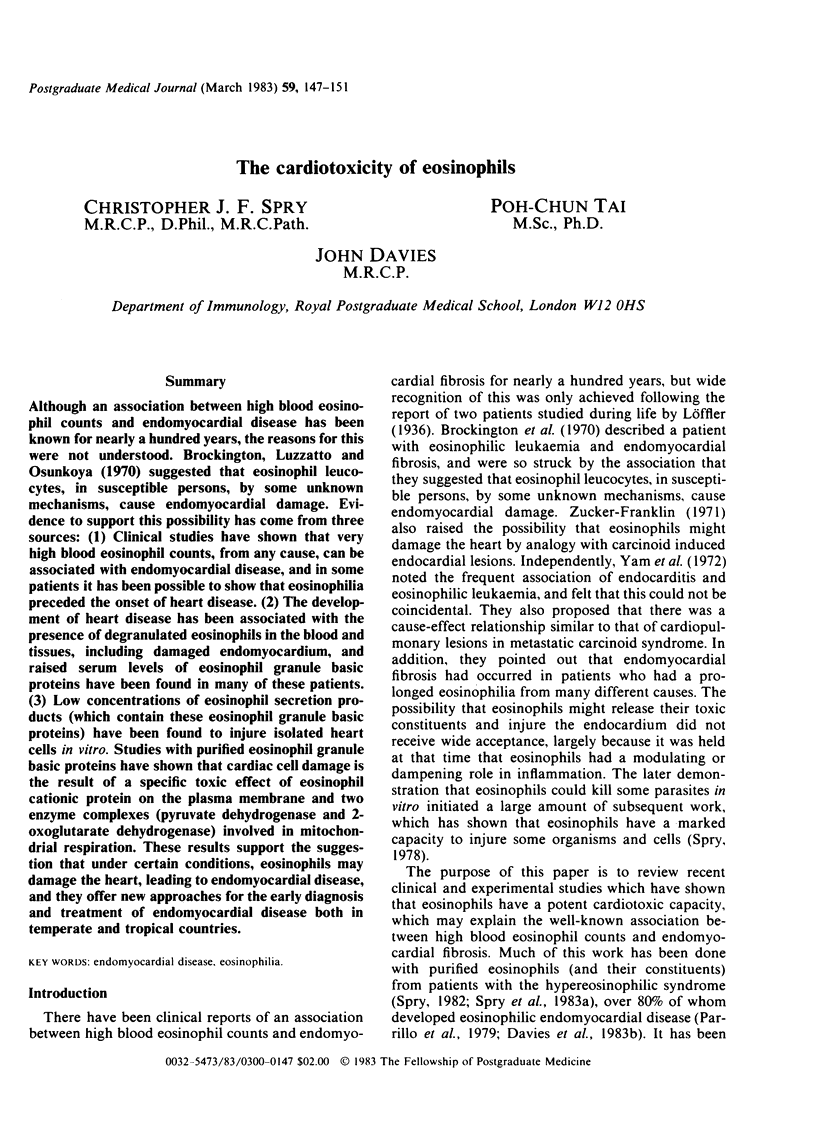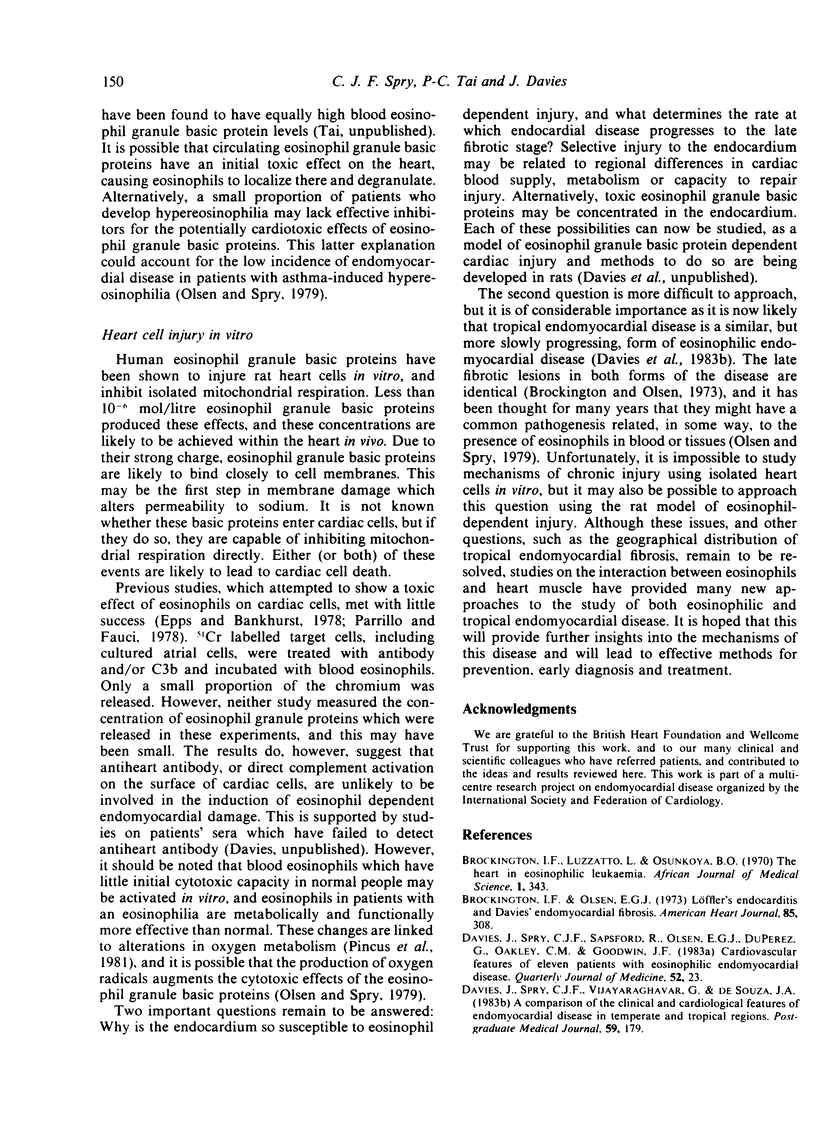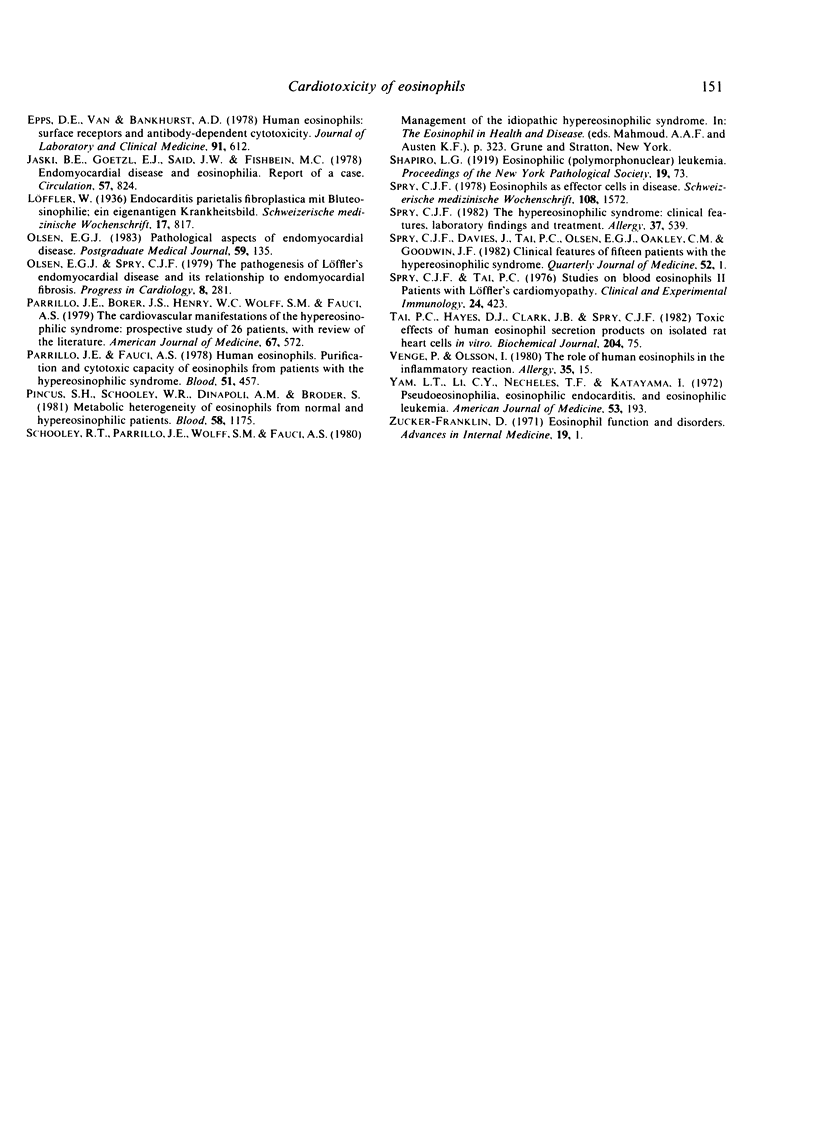Abstract
Although an association between high blood eosinophil counts and endomyocardial disease has been known for nearly a hundred years, the reasons for this were not understood. Brockington, Luzzatto and Osunkoya (1970) suggested that eosinophil leucocytes, in susceptible persons, by some unknown mechanisms, cause endomyocardial damage. Evidence to support this possibility has come from three sources: (1) Clinical studies have shown that very high blood eosinophil counts, from any cause, can be associated with endomyocardial disease, and in some patients it has been possible to show that eosinophilia preceded the onset of heart disease. (2) The development of heart disease has been associated with the presence of degranulated eosinophils in the blood and tissues, including damaged endomyocardium, and raised serum levels of eosinophil granule basic proteins have been found in many of these patients. (3) Low concentrations of eosinophil secretion products (which contain these eosinophil granule basic proteins) have been found to injure isolated heart cells in vitro. Studies with purified eosinophil granule basic proteins have shown that cardiac cell damage is the result of a specific toxic effect of eosinophil cationic protein on the plasma membrane and two enzyme complexes (pyruvate dehydrogenase and 2-oxoglutarate dehydrogenase) involved in mitochondrial respiration. These results support the suggestion that under certain conditions, eosinophils may damage the heart, leading to endomyocardial disease, and they offer new approaches for the early diagnosis and treatment of endomyocardial disease both in temperate and tropical countries.
Full text
PDF




Selected References
These references are in PubMed. This may not be the complete list of references from this article.
- Brockington I. F., Luzzatto L., Osunkoya B. O. The heart in eosinophilic leukaemia. Afr J Med Sci. 1970 Jul;1(3):343–352. [PubMed] [Google Scholar]
- Davies J., Spry C. J., Vijayaraghavan G., De Souza J. A. A comparison of the clinical and cardiological features of endomyocardial disease in temperate and tropical regions. Postgrad Med J. 1983 Mar;59(689):179–185. doi: 10.1136/pgmj.59.689.179. [DOI] [PMC free article] [PubMed] [Google Scholar]
- Haahtela T., Jokela H. Influence of the pollen season on immediate skin test reactivity to common allergens. Allergy. 1980 Jan;35(1):15–21. doi: 10.1111/j.1398-9995.1980.tb01712.x. [DOI] [PubMed] [Google Scholar]
- Jaski B. E., Goetzl E. J., Said J. W., Fishbein M. C. Endomyocardial disease and eosinophilia. Report of a case. Circulation. 1978 Apr;57(4):824–827. doi: 10.1161/01.cir.57.4.824. [DOI] [PubMed] [Google Scholar]
- Olsen E. G. Pathological aspects of endomyocardial fibrosis. Postgrad Med J. 1983 Mar;59(689):135–141. doi: 10.1136/pgmj.59.689.135. [DOI] [PMC free article] [PubMed] [Google Scholar]
- Parrillo J. E., Borer J. S., Henry W. L., Wolff S. M., Fauci A. S. The cardiovascular manifestations of the hypereosinophilic syndrome. Prospective study of 26 patients, with review of the literature. Am J Med. 1979 Oct;67(4):572–582. doi: 10.1016/0002-9343(79)90227-4. [DOI] [PubMed] [Google Scholar]
- Parrillo J. E., Fauci A. S. Human eosinophils. Purification and cytotoxic capability of eosinophils from patients with the hypereosinophilic syndrome. Blood. 1978 Mar;51(3):457–473. [PubMed] [Google Scholar]
- Pincus S. H., Schooley W. R., DiNapoli A. M., Broder S. Metabolic heterogeneity of eosinophils from normal and hypereosinophilic patients. Blood. 1981 Dec;58(6):1175–1181. [PubMed] [Google Scholar]
- Spry C. J. Eosinophils as effector cells in disease. Schweiz Med Wochenschr. 1978 Oct 14;108(41):1572–1576. [PubMed] [Google Scholar]
- Spry C. J., Tai P. C. Studies on blood eosinophils. II. Patients with Löffler's cardiomyopathy. Clin Exp Immunol. 1976 Jun;24(3):423–434. [PMC free article] [PubMed] [Google Scholar]
- Spry C. J. The hypereosinophilic syndrome: clinical features, laboratory findings and treatment. Allergy. 1982 Nov;37(8):539–551. doi: 10.1111/j.1398-9995.1982.tb02339.x. [DOI] [PubMed] [Google Scholar]
- Tai P. C., Hayes D. J., Clark J. B., Spry C. J. Toxic effects of human eosinophil products on isolated rat heart cells in vitro. Biochem J. 1982 Apr 15;204(1):75–80. doi: 10.1042/bj2040075. [DOI] [PMC free article] [PubMed] [Google Scholar]
- Van Epps D. E., Bankhurst A. D. Human eosinophils: surface receptors and antibody-dependent cytotoxicity. J Lab Clin Med. 1978 Apr;91(4):612–617. [PubMed] [Google Scholar]
- Yam L. T., Li C. Y., Necheles T. F., Katayama I. Pseudoeosinophilia, eosinophilic endocarditis and eosinophilic leukemia. Am J Med. 1972 Aug;53(2):193–202. doi: 10.1016/0002-9343(72)90129-5. [DOI] [PubMed] [Google Scholar]
- Zucker-Franklin D. Eosinophil function and disorders. Adv Intern Med. 1974;19:1–25. [PubMed] [Google Scholar]


